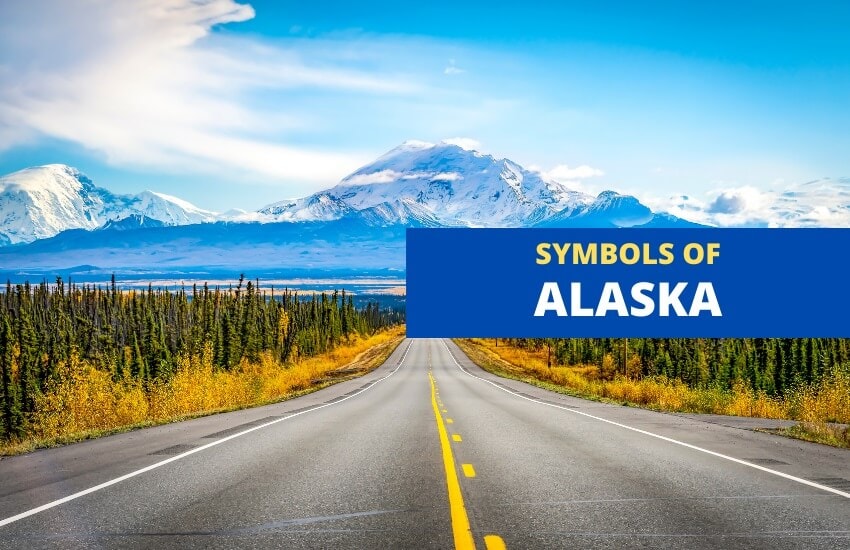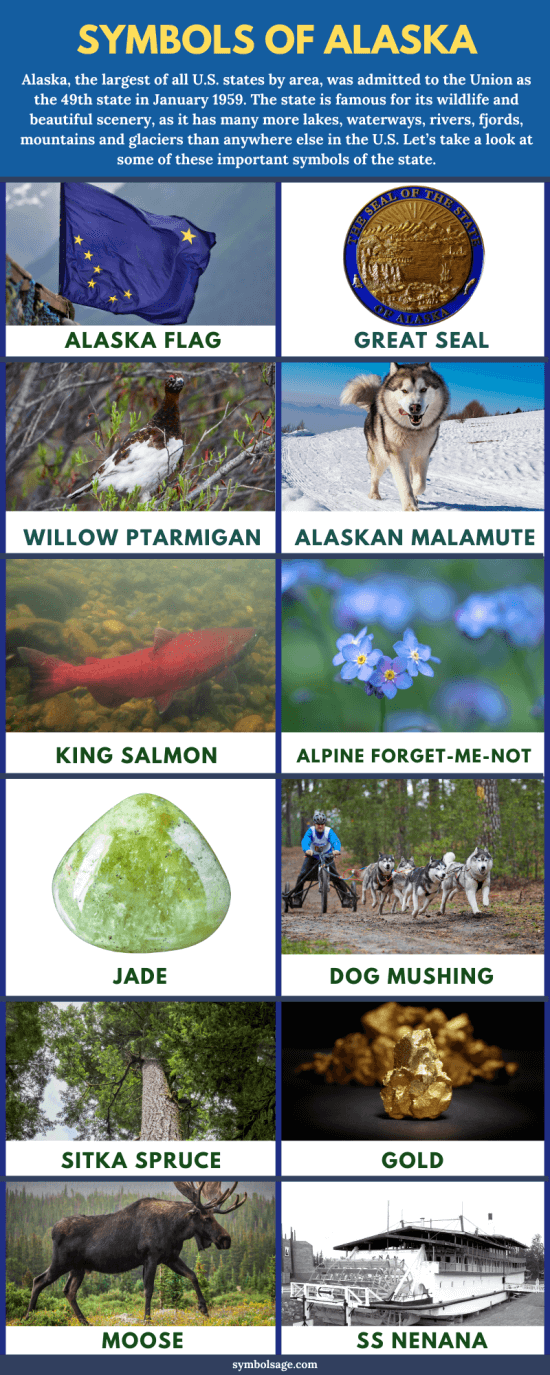
Table of Contents
Alaska, the largest of all U.S. states by area, was admitted to the Union as the 49th state in January 1959. The state is famous for its wildlife and beautiful scenery, as it has many more lakes, waterways, rivers, fjords, mountains and glaciers than anywhere else in the U.S.
Alaska has about 12 state symbols (both official and unofficial) which represent its history, culture and the ruggedness and extreme beauty of the landscape. Let’s take a look at some of these important symbols of the state and their significance.

Flag of Alaska
The state flag of Alaska is quite different from those of all the other U.S. states, featuring The Big Dipper (‘Great Bear’ or ‘Ursa Major’ constellation) in gold with a single large star on the top right hand corner. The constellation represents strength, while the star (known as ‘Polaris’ or the North Star) is symbolic of the state’s northern location.
The constellation and the North Star are superimposed on a dark blue field which represents the sea, sky, wildflowers and lakes of the state.
The flag was designed by Benny Benson, a 7th grader from an orphanage in Alaska, and was chosen for its originality, simplicity and symbolism.
Seal of Alaska
The Great Seal of Alaska was designed in 1910, when Alaska was still a territory. It’s a circular seal featuring a mountain range. Above the rage are rays that represent the Northern Lights, a smelter which symbolizes the mining industry of the state, ships which signify marine transportation and a train which symbolizes the state’s rail transportation. The trees on the left side of the seal stand for the forests of Alaska and farmer, the horse and three bundles of wheat represent the state’s agriculture.
On the outer circle of the seal is a fish and a seal representing the importance of wildlife and seafood to the economy of the state, and the words ‘The Seal of the State of Alaska’.
Willow Ptarmigan
The willow ptarmigan is an arctic grouse named the official bird of the state of Alaska in 1955. These birds are usually a light brown color in summer but they tend to change their color with the seasons, turning snow white in winter which works as an effective camouflage to protect them from predators. They feed on mosses, lichens, twigs, willow buds, berries and seeds whenever available during winter and in the summer they prefer vegetable matter and the occasional beetles or caterpillars. They’re social during the winter months and usually roost and feed in the snow in groups.
Alaskan Malamute
The Alaskan Malamute has been in North America for over 5,000 years, playing an important role in the history of the state. Malamutes are among the oldest Arctic sled dogs, named after the Inuit ‘Mahlemut’ tribe who settled along the shores of upper western Alaska. They guarded caribou herds, stayed on the lookout for bears and they even took care of the Inuit children while their parents were out hunting which is why they make great family pets.
In 2010, thanks to the efforts of the students at Polaris K-12 School situated in Anchorage, the Alaskan Malamute was officially adopted as the state dog of Alaska because of its importance and long history.
King Salmon
In 1962, the state legislature of Alaska designated the king salmon as the official fish of the state since some of the biggest king salmon on record have been caught in Alaskan waters.
Native to the North America, the king salmon is the largest of all types of Pacific salmon with adult king salmon reaching over 100 pounds in weight. The salmon typically hatch in fresh water and spend a certain part of their life in the ocean. Later, they return to the freshwater stream in which they were born to spawn and after spawning – they die. Each female lays anywhere from 3,000 to 14,000 eggs in multiple gravel nests after which it dies.
The Alpine Forget-Me-Not
Named the official flower of the state of Alaska in 1917, the Alpine forget-me-not belongs to some of the very few plant families which display true blue flowers. This flowering plant grows incredibly well throughout Alaska in rocky, open places high up in the mountains and is considered to be a symbol of true love. The flowers are usually used to decorate gifts or given as gifts and a way of saying ‘don’t forget me’. It’s also symbolic of loving memories, loyalty and faithful love.
Jade
Jade is a type of mineral mostly used for ornamental purposes and known for its beautiful green varieties. In Alaska, large deposits of jade have been discovered and there’s also an entire jade mountain located on the Seward Peninsula. Before the late 18th century, native Eskimos used to trade jade just like they traded copper, furs and hides.
The quality of Alaskan jade varies considerably and the finest quality material is usually found in stream-rolled, smooth boulders which are usually covered with a thin coat of brownish material due to weathering. Once cleaned, the smooth green jade is revealed. Due to its abundance and value, the state of Alaska designated this mineral as the official state gem in 1968.
Dog Mushing
Dog mushing is a popular sport, and transport method, which involves using one or more dogs to pull a rig over dry land or a sled on snow. This practice dates back to about 2000 BC, originating in North America and Siberia where dogs were used by many Native American cultures to pull loads.
Today mushing is practiced as a sport around the world, but it can also be utilitarian. It’s the state sport of Alaska, designated in 1972, where one of the most famous sled dog races in the world is held: Iditarod Trail Sled Dog Race. Although snowmobiles have replaced dogs, mushing continues to be an increasingly popular sport not only in Alaska but around the world.
Sitka Spruce
The Sitka Spruce is a well-known coniferous, evergreen tree famous for being the tallest of its kind in the world. The moist ocean air and the summer fog in Alaska is the main reason for the spruce’s large growth. These trees provide great roosting spots for peregrine falcons and bald eagles and other animals like porcupines, bear, elk and rabbits browse through its foliage.
The Sitka spruce is native to northwest America, found mostly on the coast from north California to Alaska. It’s a valuable tree to the people of Alaska, used for creating many products such as oars, ladders, aircraft components and sounding boards for musical instruments which is why it was designated as the official tree of the state in 1962.
Gold
In the mid-1800s, the Alaska Gold Rush brought thousands of people to Alaska and again in the 1900s when the precious metal was discovered near Fairbanks. Gold, with its chemical and physical properties, is used n coins, jewelry and art. But its uses go beyond this. It’s a malleable but dense metal and one of the best conductors of electricity which is why it’s a critical resource in medicine, dentistry and electronic instruments.
Most of the gold that’s mined in Alaska comes from the gravel and sand of rivers and streams. Alaska is said to produce more gold than any other U.S. state except for Nevada. It was namded the state mineral in 1968.
SS Nenana
A majestic ship with five decks, the SS Nenana was built in Nenana, Alaska by the Berg Shipbuilding Company. Launched in 1933, the ship was built as a packet which means she was capable of carrying both freight and passengers. Nenana played an important role in World War II by military cargo and transporting supplies to several military establishments in the defense system of Alaska.
The Nenana was opened as a museum ship in 1957 and today she’s docked in Pioneer Park. Extensive restoration programs have begun to return the ship to her former glory since she had been damaged by souvenir hunters, weather and neglect. She remains the only surviving wooden ship of her type in the U.S. and was declared a National Historic Landmark in 1989.
The Moose
The Alaskan moose is the largest of all moose in the world, weighing between 1,000 to 1600 pounds. Designated the official land mammal of Alaska in 1998, this animal mostly inhabits the northern forests of North America, Russia and Europe.
Moose have long, sturdy legs, small tails, heavy bodies, drooping noses and a dewlap or ‘bell’ under their chins. Their color ranges from a golden brown to black depending on the age of the animal and the season.
In Alaska, finding moose in people’s yards during winter is considered quite typical as it happens all the time. Historically, moose were important as a source of food and clothing and they’re still respected because of their importance in the history of the state.
Check out our related articles on other popular state symbols:
Symbols of Pennsylvania








